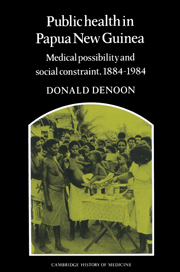Book contents
- Frontmatter
- Contents
- Acknowledgements
- Maps of Papua New Guinea
- Introduction
- I The rise and fall of tropical medicine
- II The rise and fall of the great campaigns
- 8 Miracle drugs, new perceptions and the post-war Public Health Department
- 9 The health campaigns
- 10 Women and children last
- 11 Health education
- 12 A national health system
- 13 Primary health care
- 14 The past and the future
- Notes
- Bibliography
- Index
13 - Primary health care
Published online by Cambridge University Press: 11 February 2010
- Frontmatter
- Contents
- Acknowledgements
- Maps of Papua New Guinea
- Introduction
- I The rise and fall of tropical medicine
- II The rise and fall of the great campaigns
- 8 Miracle drugs, new perceptions and the post-war Public Health Department
- 9 The health campaigns
- 10 Women and children last
- 11 Health education
- 12 A national health system
- 13 Primary health care
- 14 The past and the future
- Notes
- Bibliography
- Index
Summary
The ideas and techniques of medical care between the wars could be grouped together under the rubric of ‘tropical medicine’, an organising principle which gave those ideas a general coherence. The massive expansion of medical knowledge and drugs during the 1940s burst the limits of that organising principle: so many infections could be prevented or cured, that medical administrators need no longer rely on quarantine and segregation to defend the health of small enclaves of well-being. Scragg describes the post-war years as the ‘curative era’. The great campaigns of those years, when western medicine took the offensive against specific infections, asserted that tropical people need no longer suffer more intensely than temperate societies.
The emergence of a new organising principle lagged behind the technical changes which made it necessary. Meanwhile, medical planners were abandoning their earlier models of health and disease. They were responding not only to a more sophisticated epidemiology, which observed that much ‘tropical’ ill-health was a consequence of poverty rather than physical environment. They also responded to the political independence of many tropical colonies. The social tendency of tropical medicine – to protect privileged minorities and to acquiesce in the morbidity of the majority – jarred against the rhetoric of newly independent governments. There was also the intriguing example of China's barefoot doctors, and the collaboration of traditional Chinese and modern western specialists.
- Type
- Chapter
- Information
- Public Health in Papua New GuineaMedical Possibility and Social Constraint, 1884–1984, pp. 105 - 113Publisher: Cambridge University PressPrint publication year: 1989

